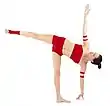List of yoga schools
Yoga schools are as diverse as the meanings of the bracket term yoga. Within the major branches of yoga such as haṭha, lāya, rāja, jñāna, and bhakti there are many different schools and lineages, both extant and defunct. Since the late 19th century, a great number of distinct new styles of "Yoga" have been introduced by individual teachers. There are also a number of schools and traditions that are occasionally referred to as yoga or yogic for their similar practices despite having no foundation in the Indian tradition such as Shin Shin Tōitsu-dō, and Daoyin.
Modern Hinduism and Neo-Hindu revival
The term "Yoga" has been used for various philosophies and concepts in the context of Hindu revivalism and Neo-Hindu religious and philosophical movements.
- 1918: The Yoga Institute - Shri Yogendra
- 1920: Agni Yoga - Nicholas Roerich and his wife Helena Roerich (theosophy)
- 1921: Integral Yoga - Sri Aurobindo, The Synthesis of Yoga
- 1934: Vinyasa Krama Yoga - Sri Tirumalai Krishnamacharya
- 1946: Kriya Yoga - Paramahansa Yogananda, Autobiography of a Yogi
- 1948: Yoga of Synthesis - Swami Sivananda
- 1950s: Satyananda Yoga - Swami Satyananda Saraswati
- 1994: Bihar Yoga Bharati
- 1955: Ananda Marga - Shrii Shrii Anandamurti
- 1960s: Transcendental Meditation - Maharishi Mahesh Yogi
- 1970: Bikram Yoga - Bikram Choudhury
- 1971: Himalayan Institute of Yoga Science and Philosophy - Swami Rama
- 1970s: Siddha Yoga - Swami Muktananda
- 1970s: Surat Shabd Yoga - Sant Mat movement, Kirpal Singh
- 1970s: Sahaja Yoga, a new religious movement founded by Nirmala Srivastava
- 1981: Art of Living - Ravi Shankar
- 1984: Vethathiri Maharishi Yoga
- 1991: Shiva Yoga
- 1997: Ananda yoga - Swami Kriyananda
- 2019: Vedhakani Yoga Vidhyalaya
Styles of yoga as exercise
India and other Asian countries are home to thousands of yoga schools founded over the last century to teach yoga as exercise, which unlike all earlier forms consists in large part of asanas. Below are some that have acquired a respected name for their style of yoga.
- 1948: Ashtanga Vinyasa Yoga - Sri K. Pattabhi Jois[1]
- 1963: Bihar School of Yoga - Swami Satyananda Saraswati[2]
- 1960s: Sivananda Yoga - Swami Vishnu-devananda[1]
- 1960s: Iyengar Yoga - B.K.S. Iyengar[1]
- 1970s: Yin Yoga - Paulie Zink[3]
- 1971: Bikram Yoga - Bikram Choudhury[1]
- 1980s: Viniyoga - tradition of Tirumalai Krishnamacharya[1]
- 1980s: Rocket Yoga - Larry Schultz[4]
- 1982: Forrest Yoga - Ana T. Forrest[1]
- 1984: Simplified Kundalini Yoga - Vethathiri Maharishi
- 1986: Jivamukti Yoga - David Life and Sharon Gannon[1]
- 1992: Isha Yoga - Sadhguru Jaggi Vasudev[5]
- 1995: Power Yoga - Beryl Bender Birch[6]
- 1990s: Power Yoga - Bryan Kest[7]
- 1997: Anusara Yoga - formerly John Friend[8]
Eclectic styles
These are partially derived from concepts of Hatha yoga. Some of these yoga styles are gaining popularity amongst Western audiences:
- 1935: Kundalini Yoga described by Sivananda Saraswati
- 1969: Kundalini Yoga - Yogi Bhajan[1]
- 1974: Naked Yoga
- 1975: Zen Yoga
- 1985: Body & Brain ("Korean Yoga") - Ilchi Lee
- 1995: Laughter Yoga - Madan Kataria
Yoga in other religious traditions
With the widespread reception of the concept of "Yoga" in the west, the term has also been transferred to similar systems of meditation and exercise which are not of Indian origin. However, these yoga concepts don't have the global reach of other popular yoga forms
- Tsa lung Trul khor, a concept in Tibetan Buddhism described as "Yantra Yoga" by Chogyal Namkhai Norbu (2000)
- Kum Nye, Tibetan practice, sometimes dubbed "Kum Nye Yoga"
- Shin Shin Tōitsu-dō, a system of "mind and body unification" created by Nakamura Tempu in the 1940s which is also known as "Japanese Yoga".
- Daoyin is a similar Daoist practice in China, part of a broader meditation system which includes Qigong and Taijiquan
- Kemetic yoga, an ancient Egyptian yoga system
References
- Yoga Journal Editors. "Which Yoga is Right for You?". Yoga Journal. Retrieved 1 June 2019.
- Mishra, Dipak (29 July 2015). "City of yoga remembers biggest fan". Telegraph India.
- "Teacher Spotlight: Paulie Zink The founding master of Yin yoga". Conference Connection. Yoga Journal. March 2009. Retrieved February 12, 2013.
- "Iconic Bay Area Yoga Teacher Dies / Yoga Buzz / Yoga Blog / Yoga Journal". 2011-03-02. Retrieved 2011-04-13.
- "The most powerful Indians in 2009: 80–84". Indian Express. 9 March 2009. Archived from the original on 28 January 2011. Retrieved 25 January 2011.
- "Power Yoga". Yoga Journal. Retrieved 28 April 2019.
The original Power Yoga was developed and founded by Beryl Bender Birch, but is now a term used to describe many vigorous vinyasa styles.
- Pizer, Anne. "Power Yoga". Retrieved 7 February 2013.
- Swartz, Mimi (July 21, 2010). "The Yoga Mogul". The New York Times.
- Moksha Mantra
